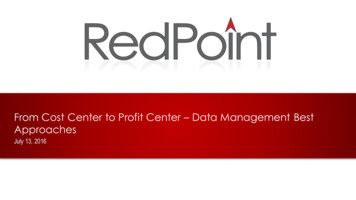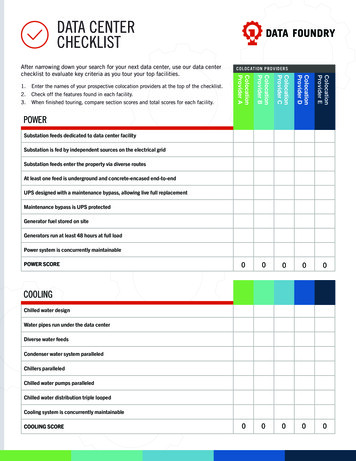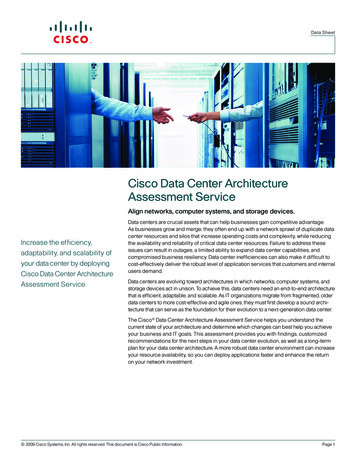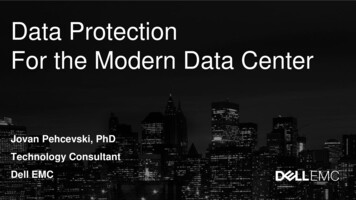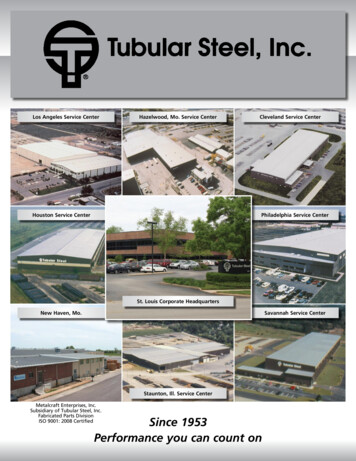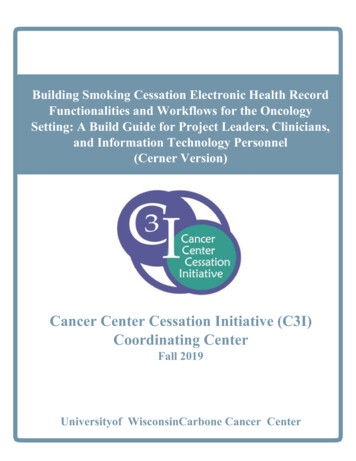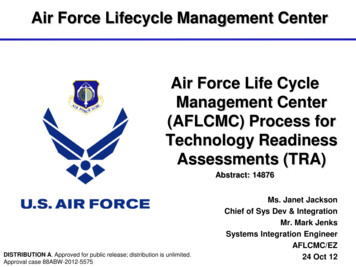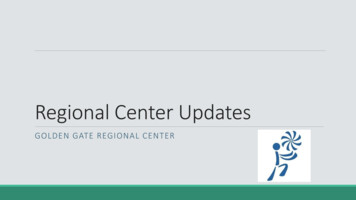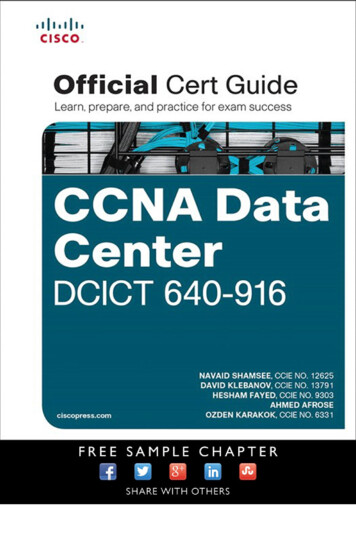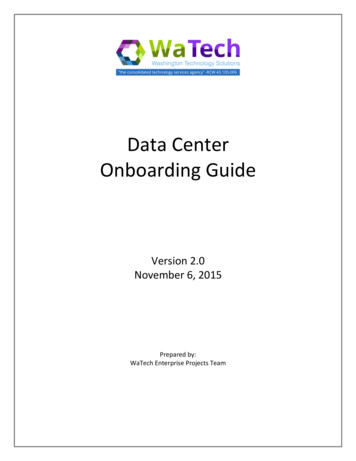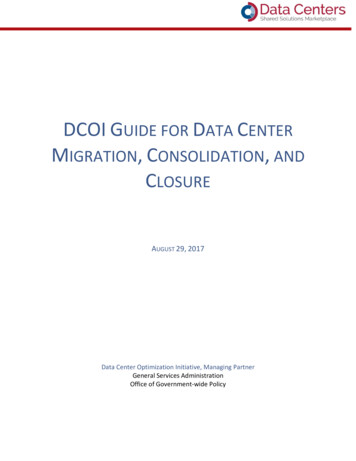
Transcription
DCOI GUIDE FOR DATA CENTERMIGRATION, CONSOLIDATION, ANDCLOSUREAUGUST 29, 2017Data Center Optimization Initiative, Managing PartnerGeneral Services AdministrationOffice of Government-wide Policy
DCOI Guide for Data Center Migration,Consolidation, and ClosurePurposeThis guide supports Federal agencies in their data center management while ensuring that planning iscomprehensive for the evaluation, migration, and consolidation of data centers. This is not anexhaustive how-to guide and does not focus on cloud migrations. This guide provides highlights and keyconsiderations for organizations in their planning process for critical activities and where typical risksoccur during the data center migration, consolidation, and closure processes. This guide supports OMBMemorandum M-16-19 “Data Center Optimization Initiative,” dated August 1, 2016. 1AudienceThe intended audience for this guidance is the agency Office of the CIO, agency project managementteams, data center operations teams, and data center migration or consolidation teams of both thephysical source and destination data centers.ObjectiveThis document is meant to help initiate, support and inform the process of data center migrations,consolidations and closures. The process at an agency should include several steps: an assessment of thedata centers, an analysis of issues and alternatives for data center consolidation, thorough planning formigrations, prioritizing, scheduling with a view of avoiding peak production periods for program users, afull destination data center preparation, move of applications (and hardware if appropriate),decommissioning of the source data center components, ensuring successful operations at thedestination data center in the case of migrations or consolidations, and data center closures – all withthe engagement of program owners. This effort should result in more consolidated, rationalized,professional, and efficient data center operations for the Government.Planning Data Center Migration, Consolidation, and ClosureThe detailed phases of this document are organized according to the following subjects: 1Organization and CommunicationsStreamlining the EnvironmentEnterprise Data Center DiscoveryAgency Data Center Optimization PlanDetailed DiscoveryApplication and Server Migration PhaseSee: /files/omb/memoranda/2016/m 16 19 1.pdfDCOI Guide for Data Center Migration, Consolidation, and ClosurePage 1
System DecommissioningData Center Closures (to be treated separately from migrations and consolidations)Organization and CommunicationsData center migrations and consolidations are complex and require committed organizationalmanagement. Transitions require a significant amount of coordination and communication at severallevels of the agency to be implemented well. Agencies should: Commit to a project management structure that will guide the organization through this process(a sample team structure and list of members 2 is provided in Figure 1 below);Liaise with cross-functional groups (as seen in Figure 1 below) to coordinate and/or assessconcerns such as scheduling impacts, staffing needs, and personnel assignments;Facilitate communications, mitigate issues and risks, and maintain overall program quality;Monitor, track and report progress to plans, progress and budget;Include both an agency engagement model and a roles and responsibilities matrix; andEnsure that the lead project manager, the migration teams, the source agency IT team, and thebusiness application owners are aligned during and after the completion of each phase.Figure 1: Sample project team organization to support data center assessments and migrations2Although Figure 1 describes the most important personnel for the source and destination project teams, everyone whonormally installs, configures, or supports both IT and facilities in either environment should be involved in the migrationprocess. By including all technical support staff, the potential number of unknown factors is significantly decreased.DCOI Guide for Data Center Migration, Consolidation, and ClosurePage 2
The lead project manager for migration 3 and the data center managers and system owners 4 are jointlyresponsible for managing and providing necessary project resources. The project managementobjectives are focused on tightly monitoring, controlling, and balancing the project’s three keyconstraints: scope, budget, and schedule. To be effective in achieving this primary managementobjective, the following should be established: An agreed-upon baseline and change control process;A process to monitor progress;A clear means of communication;An open approach for dealing with issues;A process to recognize and manage risks; andA definition of project completion.Streamlining the EnvironmentIt is important to begin streamlining the source and destination environments early in the migrationprocess. A separate team can work with program organizations and the operations and maintenanceteams to find areas of these environments to simplify. To that end, agencies should: Review and simplify the overall IT environment to facilitate the move;Remove unnecessary, outdated or obsolete applications;Ensure that applications as hosting agnostic as possible with few unusual dependencies. Theremay be some applications with unique requirements that may not perform well in generichosting, but the majority of applications will;Simplify the IT environment where possible before and in preparation of planning and executingthe physical migration of systems;Conduct server and application rationalization to optimize operations;Consider if systems can be shifted to virtual servers prior to migration; andEnsure that the results and intended changes for simplification are communicated to all otherteams involved in the process.Enterprise Data Center DiscoveryThe enterprise discovery phase includes a high-level discovery of the server and applicationenvironments to determine the best approach for the transformation of the source data center’sapplication and server environment. It includes a review of the practices, tools, and templates and3Moving forward in this guidance, the “Lead Project Manager for Migration” will be used to refer to the person in charge ofeither migration or consolidation activities. This will be similarly true for all terms related to “Migration”, which will apply bothto cases of a data center migration for reasons not related to consolidation, and those that are intended for that purpose.4System owners are defined as whomever is in charge of computing system operations (servers) at a given data centerlocation.DCOI Guide for Data Center Migration, Consolidation, and ClosurePage 3
involves the development and joint approval of the project definitions driven by the migrationcomplexity. The following events occur during enterprise discovery: Validate server and application data inventory;Evaluate network, storage and backup capabilities, requirements, and processes;Conduct business customer interviews and surveys to confirm and validate requirements andidentify risks (a set of starter interview questions are in Appendix A);Evaluate existing user authentication and authorization functionality and dependencies;Evaluate server and application dependencies and complexities: Site to site dependency analysis, including; Hardware dependency analysis; Application dependency analysis; OS versions and commercial software versions; and Server functionality analysis;Establish the scope boundaries of this analysis (sample scope templates are found in AppendixB); andEstablish initial server group candidates and proposed schedule – e.g. logical server applicationmigration groups, prerequisites, event sequencing, and very high-level move schedule.Starting InformationAgencies will need to obtain a significant amount of information about their data centers and thesystems and applications that operate within them. In addition to obtaining the required information toaddress the Optimization, Cost Savings and Avoidance, and Closed Data Centers metrics provided in M16-19, the following fundamental information will need to be collected: Established inventory of data centers with attributes including physical locations, existingphysical security and building capacity descriptions including square footage, cubic footage, rackcapacity, any containerized modular equipment, cooling and heating requirements and capacity;Organizational description, linkages and the people who work on-site and otherwise;Work activities of the data center;An inventory of stand-alone computers, racks, systems (servers), virtual machines, as well asboth operating systems and commercial software (including versions for each);For each application, a description, owner, usage cycle, the list of capabilities, system resourcerequirements, and any special requirements and dependencies;An inventory of networks (internal and external) and capabilities; andA description of any common services provided at this data center such as an authentication oronline storage system or other services (i.e. backup tape archives, UPS).Figure 2 below is a graphic depicting a typical data center technical structure, with each level needinginformation.DCOI Guide for Data Center Migration, Consolidation, and ClosurePage 4
Figure 2: Information needed for the enterprise data center migration planning processPlanning System Migration ApproachesThe server / system migration process requires detailed planning. All individual phases of the planshould be clearly established and strictly followed during execution. Success is dependent on following aprescriptive methodology and adhering to priorities that are determined prior to the actual deployment.Good communication and agreement with the technical and business owners of the systems are of theutmost importance and require excellent project management skills. A strong team at the destinationdata center is key to ingest the systems and stabilize them for a smooth transition.While there are a wide variety of issues during migrations, there are essentially only two broad types ofdata center migrations:1. A swing migration (moving the hardware / systems), where a temporary hosting server locationfor the applications is provided for operations for the period while the source servers arephysically moved and installed in the destination data center. An example of a variation of this(e.g., for internal applications) is to shut down the application on Friday evening, move theservers over the weekend, and operate the servers in the new location on Monday morning.This approach includes a service shutdown for the move days, which may not be viable,depending on the criticality of the applications. If equipment and commercial licensed softwareis to be transferred to the new data center, the financial obligations for those are part of thenegotiations for service from the destination data center. Servers that are due for hardwareDCOI Guide for Data Center Migration, Consolidation, and ClosurePage 5
refresh within the transformation period can be treated as swing servers and will not involveany activities which require remediation. The swing method allows for a back-out plan to enablebusiness operations to resume if the migration exceeds the planned application outage window.Swing migrations provide duplicate platforms so the application and data can be recovered atthe source data center location if the first attempt at migration is not successful.2. A push/pull migration, where the applications are transferred to the destination data centerand installed on the resident servers without a prior transfer of equipment. 5 The transfer ismade by a (push or pull) transmission earlier for provisioning at the new location and tested.Then, the latest database (and any other files changed by transactions) may be transmittedagain on the night of the changeover. The changeover may require the system to be unavailablefor a few minutes for the network changes or may have no downtime at all. Another approach isto leave the source system in read-only mode during the period after the final live data istransitioned to the destination data center. The push/pull method requires careful scheduleplanning and execution since it can take as much as 12 hours or more to rebuild a stack if thetransition is not successful. This window covers the total time required to accomplish databackup, de-installation, transmission to new site, reinstallation, basic testing, and useracceptance testing, consuming expensive staff and contractor hours while waiting. If thetransition cannot be accomplished in the planned time, then operations remain with sourcedata center for another week until the destination center can solve the issues that remain.Whenever possible, use a “move as-is” system approach, where activities are accomplished as much aspossible before applications are migrated to the new data center. This approach will reduce complexityand risk during the actual data center move. However, this “lift and shift” is never as simple as the wordssound and still requires substantial planning and testing. Change management controls will be neededto assist in tracking the application updates and migration schedules for each business unit.Decommissioning the source data center servers is important so they can be repurposed or surplused.Source systems should not be decommissioned until after the final concurrences by the system owner atthe destination data center and the period of possible fallback is passed. Decommissioning processesare discussed later.Agency Data Center Optimization PlanBased on the latest available information gathered, the agency’s Plan to Optimize Physical Data Centers(as required by OMB Memo M-16-19) will be updated to rationalize the most efficient path forward.Based on the significance of change of fin
destination data center in the case of migrations or consolidations, and data center closures – all with the engagement of program owners. This effort should result in more consolidated, rationalized, professional, and efficient data center operations for the Government. Planning Data Center Migration, Consolidation, and Closure

